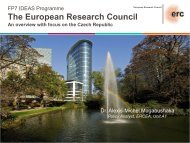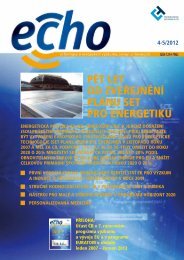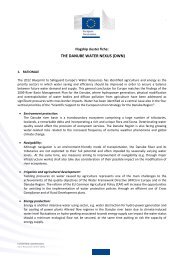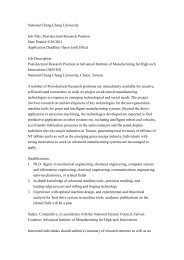Guide to Research and Innovation Strategies for Smart Specialisation
Guide to Research and Innovation Strategies for Smart Specialisation
Guide to Research and Innovation Strategies for Smart Specialisation
Create successful ePaper yourself
Turn your PDF publications into a flip-book with our unique Google optimized e-Paper software.
Science parks provide the advanced infrastructure on which research intensive enterprises<br />
rely, besides the location fac<strong>to</strong>r, being often in close proximity <strong>to</strong> a university. They provide<br />
the necessary infrastructures <strong>for</strong> research, such as advanced ICTs, <strong>and</strong> are expected <strong>to</strong> create<br />
also proper conditions <strong>for</strong> in<strong>for</strong>mal exchanges between firms, creating a specific social milieu.<br />
They can also provide complementary services <strong>and</strong> support <strong>to</strong> local firms. Spin-offs <strong>and</strong><br />
SMEs can o find in science parks wider support services that allow them <strong>to</strong> better focus on<br />
their core business <strong>and</strong> on research <strong>for</strong> the development of innovations. They are usually<br />
associated with strong networking effects <strong>and</strong> high levels of social capital. They also provide<br />
the visibility <strong>and</strong> hence attraction <strong>to</strong> wider local strategies aiming at the creation of conditions<br />
<strong>for</strong> high-tech industries <strong>to</strong> prosper.<br />
Sec<strong>to</strong>ral excellence centres can be split in<strong>to</strong> two categories: sec<strong>to</strong>ral centres targeting specific<br />
industries (providing a range of specialised services, directly <strong>to</strong> firms) <strong>and</strong> cross-sec<strong>to</strong>r centres<br />
concerned with generic issues (such as product development, work in partnership...).<br />
Business <strong>and</strong> innovation Centres (BICs) are support organisations <strong>for</strong> innovative small <strong>and</strong><br />
medium-sized businesses (SMEs) <strong>and</strong> entrepreneurs. The BICs are recognised by the<br />
European commission through a quality certification theme, which enables them <strong>to</strong> obtain the<br />
European 'EC BIC' label.<br />
Operating in the public interest, they are set up by the principal economic opera<strong>to</strong>rs in an area<br />
or region in order <strong>to</strong> offer a range of integrated guidance <strong>and</strong> support services <strong>for</strong> projects<br />
carried out by innovative SMEs, thereby contributing <strong>to</strong> regional <strong>and</strong> local development 62 .<br />
The BICs are grouped <strong>to</strong>gether within the European BIC Network (EBN). Lessons from the<br />
'Living Labs': by engaging user groups or at least by looking on innovations from the<br />
perspectives of user groups, the strengths <strong>and</strong> weaknesses of the eco-innovation system could<br />
be identified <strong>and</strong> addressed.<br />
Barriers <strong>and</strong> Challenges<br />
First, there is still a lack of a consistent strategy of Europe’s regions <strong>and</strong> MS by setting their<br />
own priorities <strong>and</strong> developing their own roadmaps. Nevertheless a dynamics is in place,<br />
stimulated by the European Strategy Forum <strong>for</strong> <strong>Research</strong> Infrastructures (ESFRI) <strong>and</strong> EC<br />
work, which should not be hindered by a lack of European consolidated vision in the near<br />
future.<br />
Member States, which constitute the convergence <strong>and</strong> outermost regions, do not often have<br />
ambitions <strong>to</strong> host the site <strong>and</strong>/or <strong>to</strong> coordinate a large multidisciplinary infrastructure. They<br />
are involved almost exclusively through participation in construction <strong>and</strong> exploitation of the<br />
new infrastructures localised in the EU15 MS, <strong>and</strong>/or by setting-up components of distributed<br />
infrastructures again coordinated by the EU15 MS.<br />
As a consequence, the distribution of research infrastructure facilities in Europe is still as<br />
disproportionate as ten years ago. Except The Extreme Light Infrastructure (ELI;<br />
http://www.extreme-light-infrastructure.eu/), The Svalbard Integrated Arctic Earth Observing<br />
62 The <strong>Smart</strong> <strong>Guide</strong> <strong>to</strong> <strong>Innovation</strong>-Based Incuba<strong>to</strong>rs (IBI), European Union - Regional Policy, February 2010.<br />
75

















